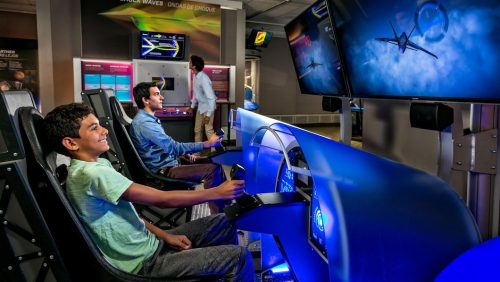Properly timed to open just before Chicago’s Museum Week, the new exhibit at the Museum of Science and Industry “Above and Beyond” takes guests’ eyes to the sky. From 747 commercial planes, to space travel, to the mighty wings of birds, the temporary exhibit offers museum goers the opportunity to explore innovations in aviation and aerospace.
The temporary exhibit, which opened earlier this month and will run up through Jan. 8, is rather small and contained compared to most of the MSI’s recent featured exhibits, though that’s not to say the exhibit itself isn’t immersive.

Anne Rashford, MSI’s director of temporary exhibits and events, helped guide the exhibit process to what it is today.
“The MSI team was met with the opportunity to host this exhibition and we thought it would be an exceptional fit for our institution,” Rashford said. “My team helped scout the exhibit and assist in the process of bringing it here to Chicago, I’m thrilled with the final outcome and I believe it truly accomplishes what we strive to achieve at MSI—to provide captivating and compelling experiences to all of our guests.”
For most, the exhibit is indeed captivating in its required participation with the exhibit guests. Many of the exhibit’s main features are comprised of motion-sensing technology that requires groups of people to simulate different flying experiences, from flapping your wings as a bird, racing supersonic planes against your friends or traveling to the edge of outer space in a space elevator.
While the exhibit and its interactive features might be geared more towards kids, adults have sure had some fun with the different featured exhibit experiences.
“This is like one of those Xbox’s we have at home, it detects your body through the camera and everything,” said Craig Olsen, who brought his son to the exhibit. “The plane racing is my favorite, it reminds me of a video game, but it’s crazy how things like this could be real one day.”
Olsen’s 12-year-old son Luke’s favorite aspect of the exhibit were the 3D models of flying cars that could one day possible become a reality.
“The flying cars were my favorite, I think it’d be really cool to have one of those,” Luke said. “I don’t know how they would pull people over or where traffic lights would be.”
Rashford believes the exhibit was intended to attract both children and adults, stating many of the featured experiences and games were aimed at both audiences in order to get them to enjoy learning more about the history and technology behind aviation.
“It features many hands-on interactive activities that we’ve seen both kids and adults enjoy. Guests can design their own fighter jet then test it on a simulated course,” Rashford said. “Above and Beyond’ offers both hands-on engagement and the opportunity to explore exciting ideas of the future.”
And while the “Above and Beyond” exhibit is indeed immersive in its featured experiences, it is a rather quick exhibit to walk through even when taking part in every activity the exhibit has to offer. If the exhibit weren’t free it’d be a bigger upset for guests, but with the confined space that the museum has, it does execute its layout quite well.
It’s hard not to make planes, space and the entire aviation history of mankind interesting and cool for kids, and that’s where the exhibit succeeds. While the plane models, the statistical numbers and the physics behind aerospace dynamics may fly over the children’s heads, the overall appreciation for the science behind aviation will stick with them.
“I hope the guests who experience ‘Above and Beyond’ walk away knowing more about the steps humankind took to fly and the technology we’re currently using to travel farther into space,” Rashford said. “I also hope this exhibit sparks even more curiosity in our guests and motivates them to learn more about flight, and maybe inspire someone to become an aerospace engineer.”

